Gyantse County is strategically located between the Himalayas and the Gangdise with the Yarlung Zangbo River flowing through the county. Being one of the key historical places only next to Lhasa and Shigatse, Gyantse plays a crucial role in connecting Front Region(including Lhasa and Shannan Prefecture) and Tsang Region(including Shigatse Area). In the ninth century, the descendants of Tubo Dynasty built their castle in one mountain as they took a fancy of the unusual terrain. In the 14th century, the leader of Sakya Dynasty built their palaces here and called it Rgyal Rtse which meant “the supreme palace”. In Qing Dynasty, the government was set in the castle, and people call this mountain Dzong. Now it is one top attraction in Gyantse.
Palcho Monastery is the main monastery in Gyantse and ringed by mountains in its three sides. In 1436, Pelkhor-tsen (the prince of Gyantse) and Gendun Drup (recognized as the first Dalai Lama) began to build Palcho Monastery and it cost as long as 10 years to accomplish it. There is a nice coherent entitle of monastery and stupa, because you can see stupa in the monastery and monastery in stupa. It is the unique monastery where Gelugpa, Sakypa and Kadampa coexist, and you can get a fuller understanding of Tibetan Buddhist Culture.
As you enter Palcho Monastery, the construction straightly ahead you is Tsulakalakang Monastery which is highlighted by the Assembly Hall (Tsochin in Tibetan, 错钦大殿 in Chinese). The entrance of Tsochin is decorated with lively statues of Four Guardian Kings, rather than ordinary paintings. Tsochen has three floors totally. The first floor is the supported 48 columns with many ancient Thangkas hanging on. The left wall in the northwest side stood a gilded bronze eight-meter statue of Jamba which is made by 14,000 kg of brasses. Three Buddha (Past Buddha, Current Buddha and Future Buddha) are enshrined in the north chapel.
On the second floor is where the highest-level meeting of Palcho Monastery are held. What you can’t miss in Tsochin is the 16 statues of Arhat, meaning a great artistic achievement of Tibetan Buddhists.
The walls on the third floor are painted with 55 delicate Mandala Murals in different scale. These murals draw the feature of Nepal and India, forming its only style. Looking upward at the ceiling, you will be attracted by the fine Hexagonal pattern in which petals of lotus and “Om mani padme hum” are drawn. Tibetan Buddhist recognized these words as source of every Buddhist classics. Chanting them repeatedly will remove evil spirits and accumulate virtue.
What makes Palcho Monastery become extraordinarily charming is Bodhi Stupa, and Tibetan people always call it Kumbum Stupa. In the history of Chinese architecture, Kumbum is an unparalleled stupa within 9 tiers, 78 chapels and 108 gates, niches and stupa halls. The stupa base has 5 tiers in an octagonal shape. The stupa body shapes like a bottle tower – the higher, the smaller. All lintels are ornamented with beautiful relieves like elephants, lions, dragons.
There are thousands images and statues of all Buddha, so stepping into Kumbum likes passing into Buddhist Kingdom. There are exclusive chapels for the leaders of Bon Sect, Mongolian Lamaism, White Sect, Yellow Sect and some other renowned Lamas. Apart from numerous exquisite Thangkas, there are also many clay sculptures, golden statues and silvery statues. All the Buddha and Bodhisattva are in different shapes and expressions. The smiling Shakyamuni with eyes closed as if he is thinking meaning of life deeply. The fierce-looking Warrior Attendant will terrify you even by the first sight. The image of Tara is charming and pretty, and you can feel her gentleness and kindness. These images and statues of Buddha show a Gyantse style containing the essence of Indian and Nepalese artistic expression and make a far-reaching influence on Tibetan statuary art. Kumbum is the only religious museum collecting architecture, painting and statues together in China.
The uniqueness of Palcho Monastery is embodied in that different sects of Tibetan Buddhist stay together here. When dispute occurs, the Dratsangs, residential quarters of the monks, are their best bases for different sects. In fact, they get along well with and learn much from each other. With Tsochin and Kumbum as a center, plenty of Dratsangs belonging different sects bestrewed in Palcho Monastery. During the most flourishing period, there were 17 Dratsangs and 16 survived. Have a careful exploration in different Drasangs, and you may be able to feel the different culture in different sects.
Murals in Palcho Monastery are rich in various forms. When looking at these murals, you may feel everything turns to be intricate and fascinating as if you place yourself in a magical labyrinth kingdom. The murals can be classified into three categories: Esoteric Buddhism, Exoteric Buddhism and human figures. Esoteric Buddhism and exoteric Buddhism both have their distinctive classics. The murals of human figures reflect the Tibetan ideal human proportions and aesthetic characteristics of Tibetan. According to the preface, the murals in Palcho Monastery are mainly created by the artists from Tsang Region like Gyantse County, Kangmar County and Nyemo County. Their different style integrated together and pulled Tibetan Buddhist art to a new stage.
>> 7 Days Lhasa Shigatse Gyantse Tour
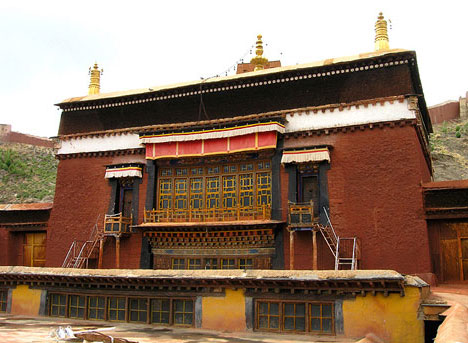 Apperance of the Main Assembly Hall
Apperance of the Main Assembly Hall
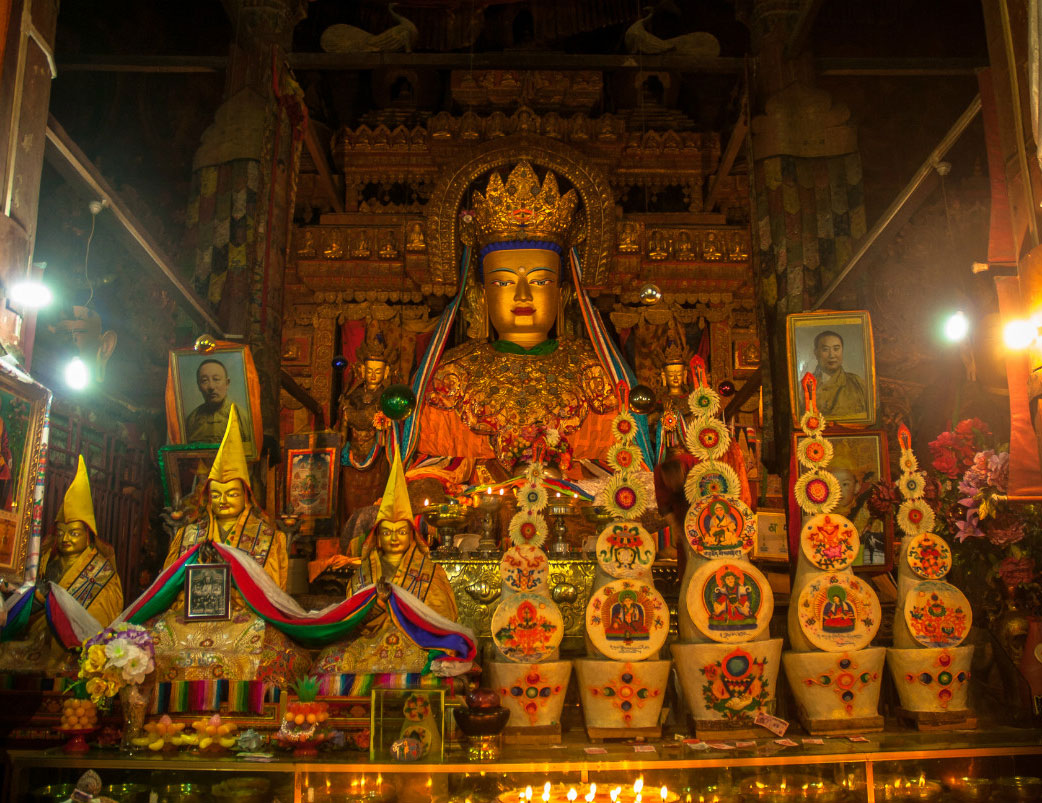 Bronze Statue of Jamba in Tsochin
Bronze Statue of Jamba in Tsochin
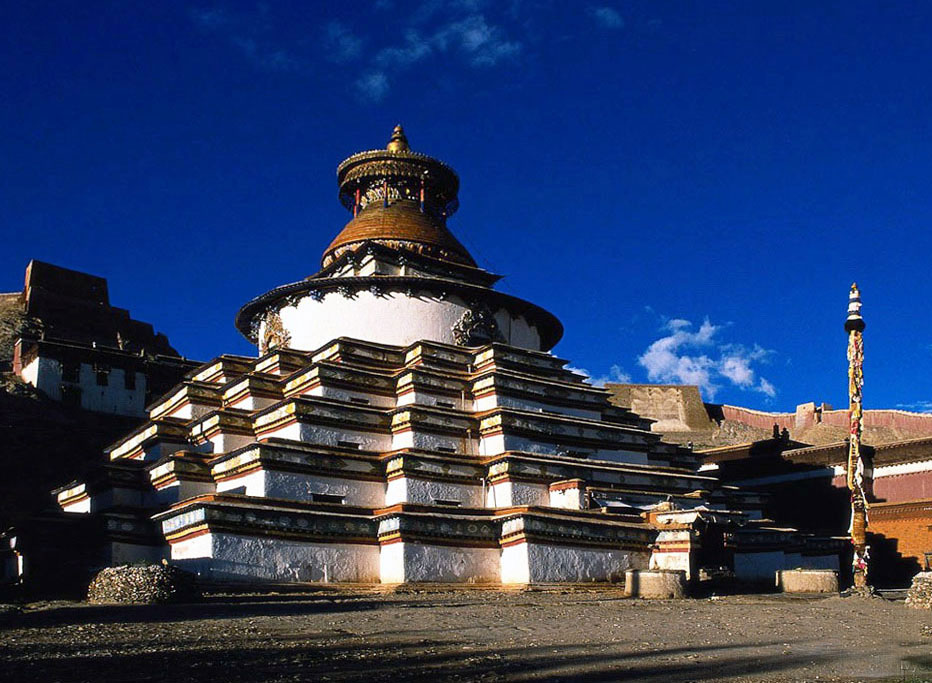 Magnificent Kumbum
Magnificent Kumbum
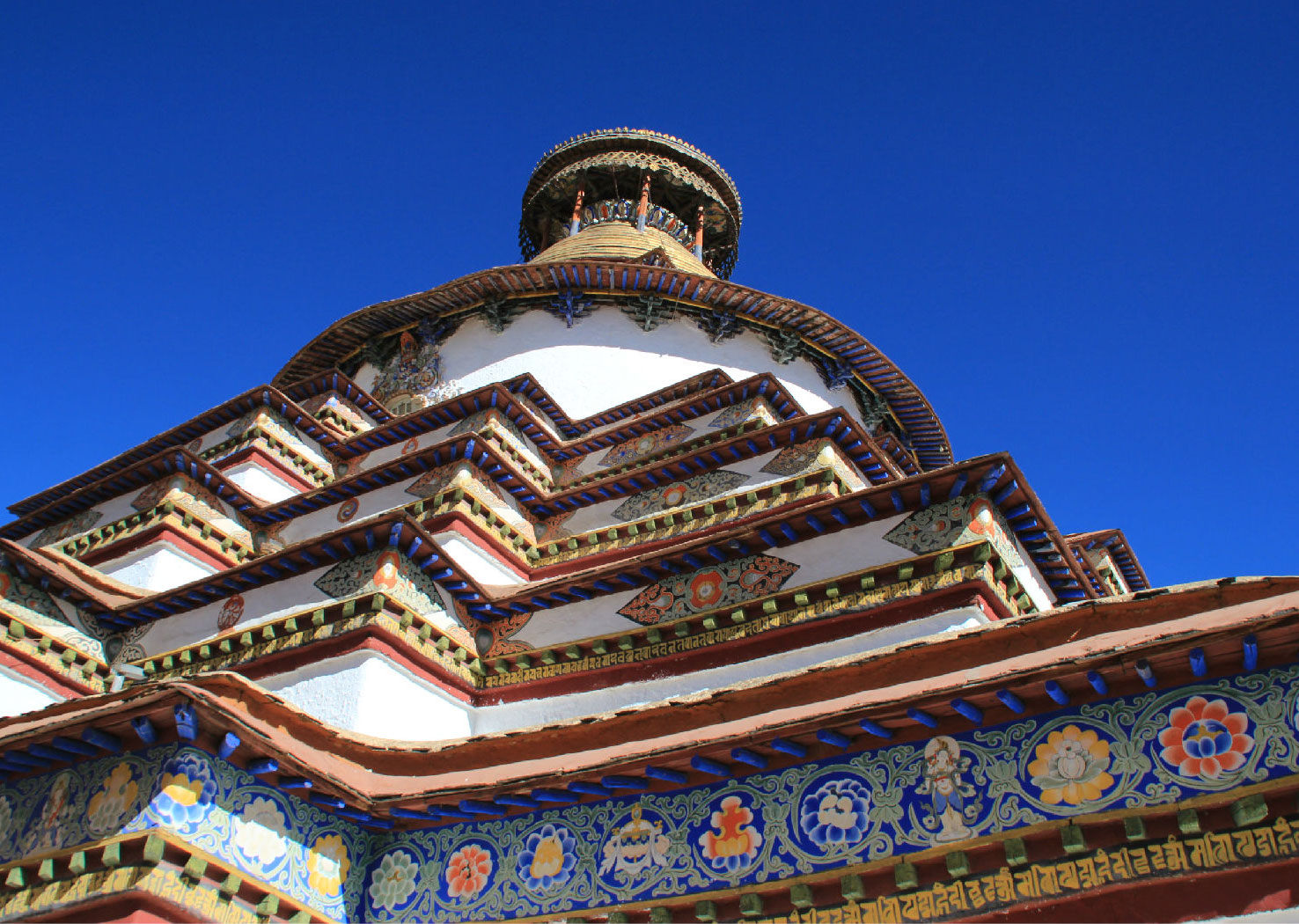 Exquisite Patterns in Kumbum
Exquisite Patterns in Kumbum
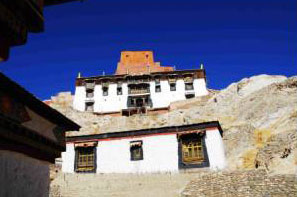 Dratsangs Scattered in Palcho Monastery
Dratsangs Scattered in Palcho Monastery
 Beautiful Mural
Beautiful Mural
Apart from Gyantse’s Monastery, there are many impressive things to do in Gyantse. Exploring them, you will have a more enjoyable experience.
Gyantse Dzong (宗山遗址) also called Gyantse Fort, founded on the rugged hills and faced with Palcho Monastery, can trace bake to 1628, has an eyes-catching presence behind Gyantse Town. In 1904, the forts were constructed to resist the violation of Britain in 1904. Being short-staffed and lack of advanced weapons, the local people jumped from the mountain to their death after three days’ bloody battles. As the result, Gyantse was regarded the City of Heroes. You can still explore the story of the heroes by visiting Dzong Relics Site. In addition, you will have a fabulous bird’s-view of Palcho Monastery within 20-minute climb up to the top of Gyantse Dzong.
Admission: 40 RMB/personPala Manor (帕拉庄园), 5.4 km away from Palcho Monastery was the main Manor of Pala Family which once to be the largest noble in Tibet. It is the only survived and well preserved manor of the three feudal lords in old Tibet. It still remains its origin charm with three floors and 57 rooms. You can feast on eyes on a richly ornamented construction with the beautifully carved beams and finely painted rafters. The bed rooms are full of gold and jade, and the precious tableware, imported wines as well as valuable fur clothes are still kept in the manor. You can imagine how deluxe it once presented.
Admission: 25 RMB/person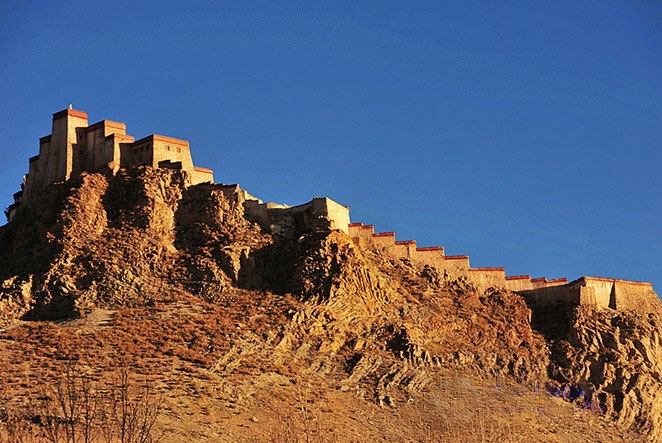 Remaining Dzong Castle
Remaining Dzong Castle
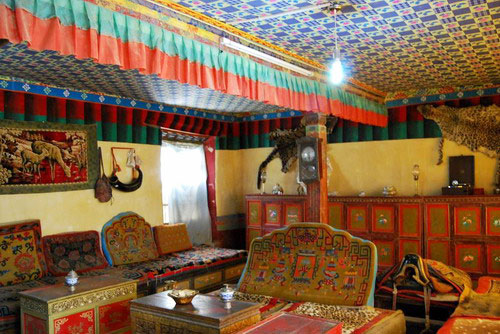 Luxurious Decoration in Pala Manor
Luxurious Decoration in Pala Manor
Located in northeast part of Gyantse County, Palcho Monastery is about 100 km away from east Shigatse and 250 km away from Lhasa.
From Shigatse: To get to Palcho Monastery, tourists should take the minibus (Shigatse - Gyantse) at Shigatse Bus Station. The ticket is about 25 RMB per person. Arriving at Gyantse, take a short walk to Palcho Monastery.
From Lhasa: There are coaches in Eastern Bus Station, Western Station and Northern Station running from Lhasa to Gyantse with 6 hours. The road is in good condition. After a short transfer, you can get to Palcho Monastery.
If you want to get rid of hustle of public transportation and troublesome navigation, you can book a private tour package which covers sightseeing, dining and transfer from us. Our knowledgeable local tour guide and skilled driver will escort you to Palcho Monastery with speed and convenience, and take care of all the details. You just need to focus on sightseeing.
Top 3 Shigatse tours chosen by most customers to explore Shigatse in the best way. Check the detailed itinerary, or tailor your own trip now with us.
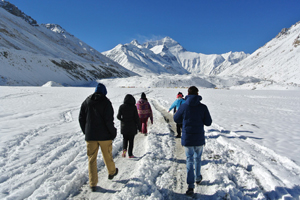
Lhasa / Gyantse / Shigatse/ Everest
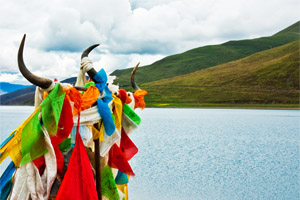
Lhasa / Gyangtse / Shigatse
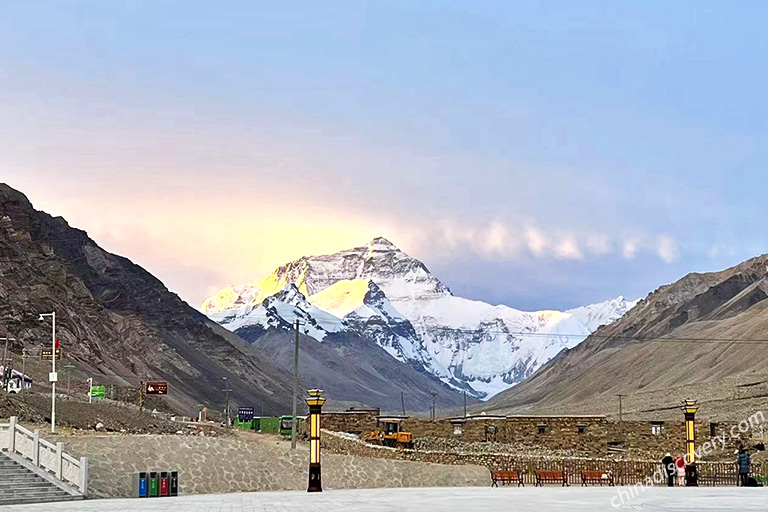
Lhasa / Gyangtse / Shigatse / Mt.Everest / Namtso Lake
Start planning your tailor-made holiday to China by contacting one of our specialists. Once inquired, you’ll get a response within 0.5~23.5 hours.
Customize a Trip